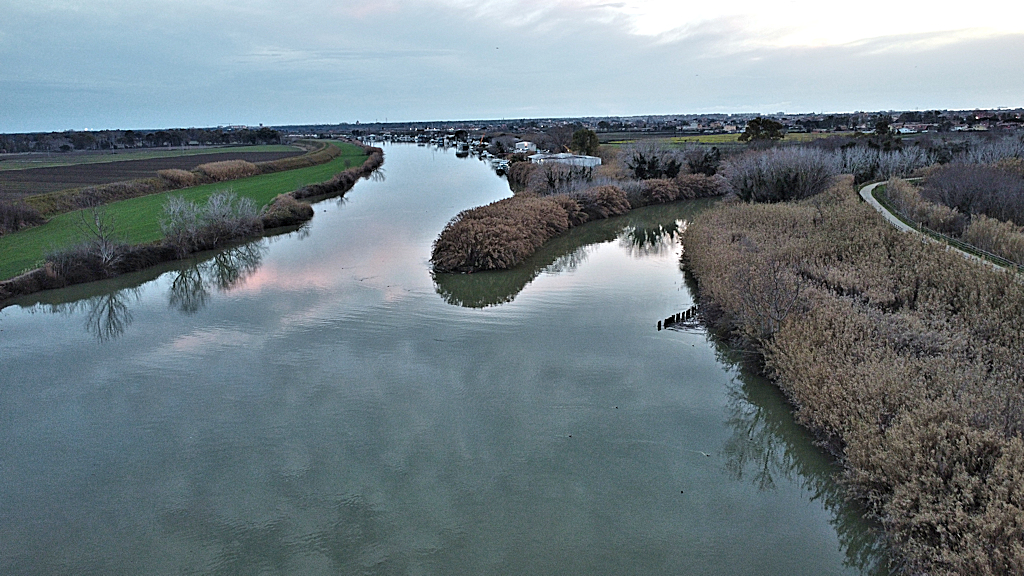Portus - The harbour of Claudius
Ostia was a problematic harbour site. It had no natural harbour, only the banks of the river Tiber could be used. Also, large ships had problems entering the river, because of a sand bar in front of the mouth. Therefore goods that arrived in large ships were often transferred to smaller ships on the sea. Large cargo ships could also be unloaded in the harbour of Puteoli, in the bay of Naples, after which the cargo was taken to Rome by road or to Ostia in smaller ships. Finally, the Tiber quays simply did not offer enough mooring space for Rome's growing needs.
In 42 AD Claudius started the construction of an artificial harbour, a few kilometres to the north of Ostia. There seems to have been a small, natural bay or lagoon here that was incorporated in the harbour basin. The basin was protected by two curved moles, between which was a small island supporting a tall lighthouse. The width and length of the basin were c. 800 meters by a few kilometers. It was seven metres deep.

Map of Portus and Ostia. North is to the left.
Three channels were dug to connect the new harbour with the sea. One was situated to the north. It was probably meant for flood relief, and 20-35 meters wide. The second, to the east, was curved and connected the Tiber with the third channel. This last channel ran to the south of the basin and was 45 metres wide. It is known as the Fossa Traiani or Traiana, but it was made by Claudius, not Trajan. This channel was in the Middle Ages called Fiumicino ("Small river"), as is the modern village at the mouth of the channel (the river leading to Ostia was called Fiumara Grande). To the south of the basin was a small inner harbour. A short transverse channel, running from north to south, connected it with the Fossa. The Fossa also created an artificial island between Ostia and Portus, called Isola Sacra ("Sacred Island") in late antiquity, earlier Assis, "axle".

Capo Due Rami ("Head of the two branches"), where the Fossa Traiana (to the right) branches off from the Tiber (to the left).
Seen from the north. Photo: Philipp Markus Schmitt.
The work of Claudius is mentioned in an inscription from 46 AD, possibly from the attic of an arch, which shows that Claudius also hoped to reduce the risk of inundations in the city of Rome, by digging channels from the Tiber to the sea. Coins from 64 AD, so from the reign of Nero, celebrate either the completion of the work in 64 AD, or the 10th anniversary of the completion of the harbour. Be that as it may, already in 62 AD the harbour was in use: in that year 200 ships in the basin perished during a storm. It has often been said that therefore Claudius' basin was unsafe, but it is more likely that the destruction was caused by a tsunami, the result of the same seismic activity that is documented in that year in Pompeii (the earthquake of February 5, 62 AD). On the coins the two moles are not identical. The one on the right (north) has arched openings. On some coins of the series (several dies were used) there seem to be a temple and an altar at the end of the left (southern) mole. The lighthouse is not depicted between the moles, but only an isolated statue of Neptunus holding a trident and a dolphin. A reclining male figure with rudder and dolphin in the lower part is the personification of the harbour.

Portus on a sesterce issued by Nero, in 64 AD. Click on the image to enlarge.
In ancient literature the harbour is called Portus Ostiensis, coins minted in Rome have the text Portus Ostiensis Augusti ("the Ostian port of the Emperor"), while coins minted in Lyon, France only have Portus Augusti. Around the basin were commercial buildings and a small residential area, witness the presence of tombs. From the harbour the goods were taken to Rome in barges that were towed by men, in late antiquity by oxen. This final stage may have been limited to autumn and winter, due to low groundwater levels in spring and summer. Cargo arrived for the most part during spring and summer, the sailing season (mare apertum, "open sea"). Therefore warehouses (horrea) were needed in the port for temporary storage. The port had its own protective deities, the Lares Portus Augusti. The Imperial administration of the harbour was led by a procurator portus Ostiensis.